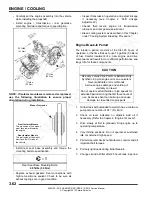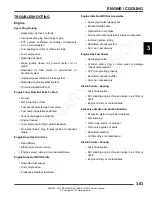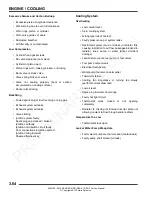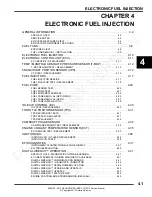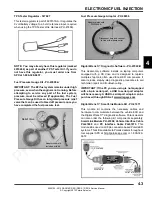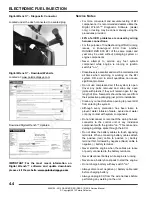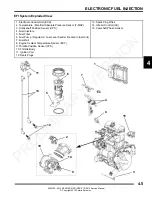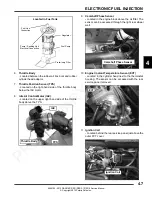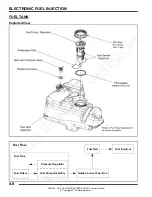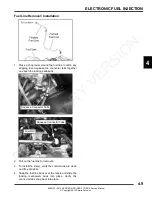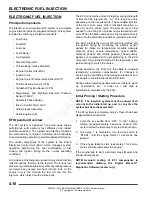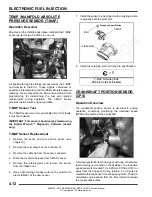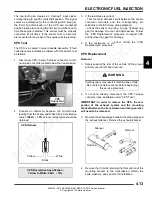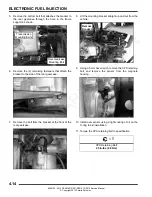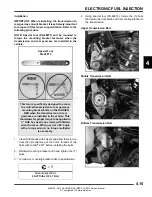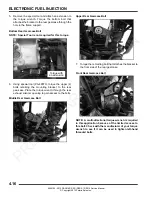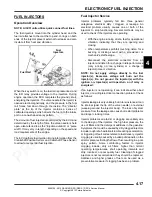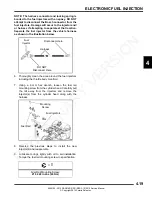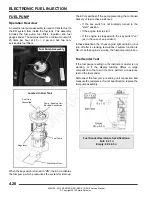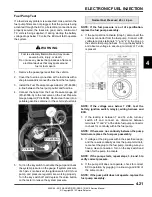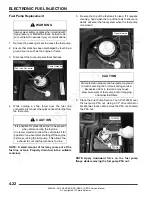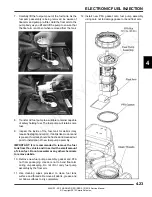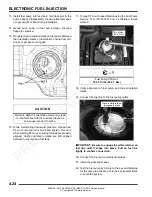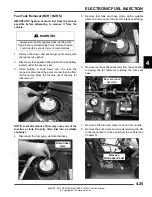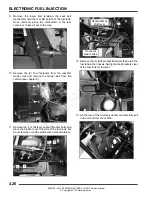
4.11
ELECTRONIC FUEL INJECTION
4
9924125 - 2013
RANGER
RZR / RZR S / RZR 4 Service Manual
© Copyright 2012 Polaris Sales Inc.
ELECTRONIC CONTROL UNIT (ECU)
Operation Overview
The ECU is the brain or central processing computer of the
entire EFI fuel/ignition management system. During
operation, sensors continuously gather data which is
relayed through the wiring harness to input circuits within
the ECU. Signals to the ECU include: ignition (on/off),
crankshaft position and speed (RPM), camshaft position
(MAG/PTO), throttle position, engine coolant
temperature, intake air temperature, intake manifold
absolute pressure and battery voltage. The ECU
compares the input signals to the programmed maps in its
memory and determines the appropriate fuel and spark
requirements for the immediate operating conditions. The
ECU then sends output signals to set the injector duration
and ignition timing.
During operation, the ECU continually performs a
diagnostic check of itself, each of the sensors, and system
performance. If a fault is detected, the ECU turns on the
“Check Engine” light in the speedometer and stores the
fault code in its fault memory. Depending on the
significance or severity of the fault, normal operation may
continue, or "Fail-Safe" operation (slowed speed, richer
running) may be initiated. A technician can determine the
cause of the “Check Engine” light by referencing the
“Instrument Cluster Trouble Code Display” and
“Diagnostic Trouble Code Table” or by using Digital
Wrench™. The ECU requires a minimum of 7.0 volts to
operate. The memory in the ECU is operational the
moment the battery cables are connected.
To prevent engine over-speed and possible failure, an
RPM limiting feature is programmed into the ECU. If the
maximum RPM limit is exceeded, the ECU suppresses the
injection signals, cutting off the fuel flow and retards the
ignition timing. This process repeats it self in rapid
succession, limiting operation to the preset maximum.
RANGER RZR 800 EFI RPM Limit:
Max RPM Limit - Injector and ignition suppression.
•
RZR:
6600 RPM (All Gears)
•
RZR S / RZR 4:
6750 RPM (All Gears)
ECU Service
Never attempt to disassemble the ECU. It is sealed to
prevent damage to internal components. Warranty is void
if the case is opened or tampered with in any way.
All operating and control functions within the ECU are pre-
set. No internal servicing or readjustment may be
performed. If a problem is encountered, and you
determine the ECU to be faulty, contact the Polaris Service
Department for specific handling instructions. Do not
replace the ECU without factory authorization.
The relationship between the ECU and the throttle position
sensor (TPS) is very critical to proper system operation. If
the TPS is faulty, or the mounting position of the TPS to the
throttle body is altered, the TPS must be adjusted.
For the purpose of troubleshooting, a known-good ECU
from another Polaris
RANGER
RZR EFI of the same
model may be used without system or engine component
damage.
ECU Replacement
1.
Remove the (2) retaining screws holding the ECU.
2.
With the ignition turned off, disconnect the wire
harness from the ECU.
3.
To install, reverse the procedure and tighten screws
to specification.
ECU
RZR / RZR S
RZR 4
- Located behind
driver’s seat
- Located under left
rear passenger seat
ECU
=
T
ECU Retaining Screws:
10 in-lbs (1.1 Nm)
PRELIMINARY
VERSION
Summary of Contents for 2013 RANGER RZR
Page 417: ...2013 RANGER RZR 800...
Page 418: ...2013 RANGER RZR 800...
Page 419: ...2013 RANGER RZR 800 EPS...
Page 420: ...2013 RANGER RZR 800 EPS...
Page 421: ...2013 RANGER RZR S 800...
Page 422: ...2013 RANGER RZR S 800...
Page 423: ...2013 RANGER RZR S 800 INT L...
Page 424: ...2013 RANGER RZR S 800 INT L...
Page 425: ...2013 RANGER RZR 4 800...
Page 426: ...2013 RANGER RZR 4 800...
Page 427: ...2013 RANGER RZR 4 800 EPS...
Page 428: ...2013 RANGER RZR 4 800 EPS...


